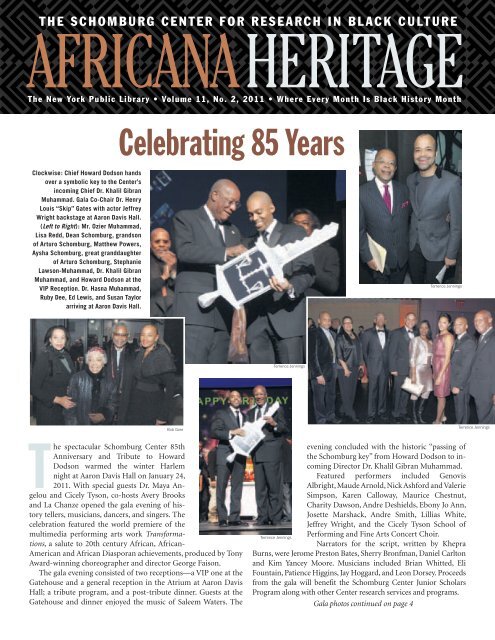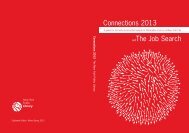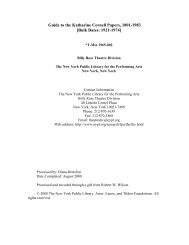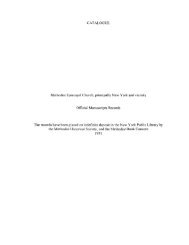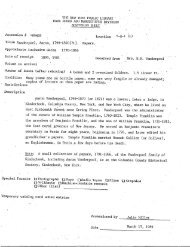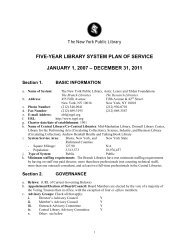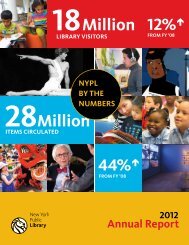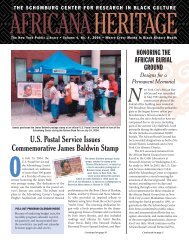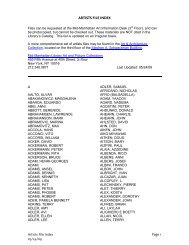Volume 11, #2 - New York Public Library
Volume 11, #2 - New York Public Library
Volume 11, #2 - New York Public Library
You also want an ePaper? Increase the reach of your titles
YUMPU automatically turns print PDFs into web optimized ePapers that Google loves.
T h e S c h o m b u r g C e n t e r f o r R e s e a r c h i n B l a c k C u lt u r e<br />
Africana Heritage<br />
The <strong>New</strong> <strong>York</strong> <strong>Public</strong> <strong>Library</strong> • <strong>Volume</strong> <strong>11</strong>, No. 2, 20<strong>11</strong> • Where Every Month Is Black History Month<br />
Celebrating 85 Years<br />
Clockwise: Chief Howard Dodson hands<br />
over a symbolic key to the Center’s<br />
incoming Chief Dr. Khalil Gibran<br />
Muhammad. Gala Co-Chair Dr. Henry<br />
Louis “Skip” Gates with actor Jeffrey<br />
Wright backstage at Aaron Davis Hall.<br />
(Left to Right): Mr. Ozier Muhammad,<br />
Lisa Redd, Dean Schomburg, grandson<br />
of Arturo Schomburg, Matthew Powers,<br />
Aysha Schomburg, great granddaughter<br />
of Arturo Schomburg, Stephanie<br />
Lawson-Muhammad, Dr. Khalil Gibran<br />
Muhammad, and Howard Dodson at the<br />
VIP Reception. Dr. Hasna Muhammad,<br />
Ruby Dee, Ed Lewis, and Susan Taylor<br />
arriving at Aaron Davis Hall.<br />
Terrence Jennings<br />
Terrence Jennings<br />
Bob Gore<br />
Terrence Jennings<br />
The spectacular Schomburg Center 85th<br />
Anniversary and Tribute to Howard<br />
Dodson warmed the winter Harlem<br />
night at Aaron Davis Hall on January 24,<br />
20<strong>11</strong>. With special guests Dr. Maya Angelou<br />
and Cicely Tyson, co-hosts Avery Brooks<br />
and La Chanze opened the gala evening of history<br />
tellers, musicians, dancers, and singers. The<br />
celebration featured the world premiere of the<br />
multimedia performing arts work Transformations,<br />
a salute to 20th century African, African-<br />
American and African Diasporan achievements, produced by Tony<br />
Award-winning choreographer and director George Faison.<br />
The gala evening consisted of two receptions—a VIP one at the<br />
Gatehouse and a general reception in the Atrium at Aaron Davis<br />
Hall; a tribute program, and a post-tribute dinner. Guests at the<br />
Gatehouse and dinner enjoyed the music of Saleem Waters. The<br />
evening concluded with the historic “passing of<br />
the Schomburg key” from Howard Dodson to incoming<br />
Director Dr. Khalil Gibran Muhammad.<br />
Featured performers included Genovis<br />
Albright, Maude Arnold, Nick Ashford and Valerie<br />
Simpson, Karen Calloway, Maurice Chestnut,<br />
Charity Dawson, Andre Deshields, Ebony Jo Ann,<br />
Josette Marshack, Andre Smith, Lillias White,<br />
Jeffrey Wright, and the Cicely Tyson School of<br />
Performing and Fine Arts Concert Choir.<br />
Terrence Jennings<br />
Narrators for the script, written by Khepra<br />
Burns, were Jerome Preston Bates, Sherry Bronfman, Daniel Carlton<br />
and Kim Yancey Moore. Musicians included Brian Whitted, Eli<br />
Fountain, Patience Higgins, Jay Hoggard, and Leon Dorsey. Proceeds<br />
from the gala will benefit the Schomburg Center Junior Scholars<br />
Program along with other Center research services and programs.<br />
Gala photos continued on page 4
F r o m t h e Chief<br />
The next words you read on this page of Africana<br />
Heritage will be that of Director-designate<br />
Khalil Gibran Muhammad. These are<br />
the last official words you will read “From<br />
this Chief.” I don’t know if Khalil will keep the<br />
Chief title, but future editor’s letter in Africana<br />
Heritage will come from him.<br />
I did not coin the title “Chief.” I inherited<br />
it. When I arrived at the Schomburg Center in<br />
September of 1984 and was shown to my office,<br />
the brass nameplate on the door read: “Chief.”<br />
It appears that my predecessors, Wendell Wray<br />
“I take this opportunity to thank you again for your support and<br />
for making me at least feel like “The Chief.” The Schomburg<br />
Center is a richer, stronger, more appreciated and revered<br />
institution because you believed in it and invested in its future.”<br />
— Howard Dodson, Schomburg Chief<br />
and Jean Blackwell Hutson, had this title before I<br />
arrived. It also appears that in its original form,<br />
it was a shortened or elevated version of The <strong>New</strong><br />
<strong>York</strong> <strong>Public</strong> <strong>Library</strong>’s job title “Chief Librarian.”<br />
I frankly didn’t know what its origins were<br />
or what it meant. But I liked it and I decided<br />
to claim it and make it my own. Within the<br />
context of African and African-American culture<br />
and lore, the word has numerous meanings. I<br />
decided not to define it but to try to live up to all<br />
the positive ways the word is associated with the<br />
concept of leadership. Ultimately, you will have<br />
to decide how much I lived up to your leadership<br />
expectations. Though my official title was/is<br />
Director of the Schomburg Center, I hope that<br />
my use of the title “Chief” has not sullied your<br />
concept of it.<br />
As announced earlier, I had planned to leave<br />
office on the first of February. As you can see, I<br />
am still here. Director-designate Dr. Muhammad<br />
has contractual obligations to his university and<br />
the American Historical Association. The <strong>New</strong><br />
<strong>York</strong> <strong>Public</strong> <strong>Library</strong> asked and I have agreed to<br />
stay on duty until July when Khalil will be free<br />
to assume his duties. Among other things, I am<br />
putting together a series of<br />
orientation sessions for Dr.<br />
Muhammad—three to five<br />
days a week every month<br />
from March to July. The<br />
goal is to pass on to him<br />
as many of my external<br />
contacts and relationships<br />
as possible while<br />
immersing him in the dayto-day<br />
operations of the Center. It is expected that<br />
by July, he will be ready to hit the ground running.<br />
I take this opportunity to thank you again<br />
for your support and for making me at least feel<br />
like “The Chief.” The Schomburg Center is a<br />
richer, stronger, more appreciated and revered<br />
institution because you believed in it and invested<br />
in its future. Its future is still linked to your<br />
commitment. Please continue to support and<br />
invest in the Schomburg Center and its new<br />
Director as he seeks to take it to higher heights.<br />
2 Africana Heritage • <strong>Volume</strong> <strong>11</strong>, No. 2, 20<strong>11</strong> • Where Every Month Is Black History Month
(Far left) Maulana Karenga<br />
and Charles Barron at The<br />
State of African American<br />
and African Diaspora<br />
Studies’ Opening Plenary.<br />
The Opening Plenary<br />
Panelists (from left):<br />
Howard Dodson, Johnetta<br />
Cole, Vincent Harding,<br />
Cathy Cohen, Maulana<br />
Karenga, and Dr. Khalil<br />
Gibran Muhammad.<br />
Terrence Jennings<br />
Terrence Jennings<br />
Bob Gore<br />
Ruby Dee addresses the<br />
audience in the Langston<br />
Hughes Auditorium during<br />
the Opening Plenary.<br />
(Left) Former Scholarsin-Residence<br />
at a special<br />
book celebration, before<br />
the Opening Plenary, with<br />
Colin Palmer (far left) and<br />
Howard Dodson (far right).<br />
Hundreds Attend the State of Black Studies Conference<br />
Bob Gore<br />
On Thursday, January 6, 20<strong>11</strong> the<br />
Schomburg Center hosted the<br />
Opening Plenary Session for The<br />
State of African American and<br />
African Diaspora Studies: Methodology,<br />
Pedagogy, and Research conference.<br />
The three-day conference, which<br />
was sponsored by the Schomburg Center<br />
for Research in Black Culture, The Institute<br />
for Research on the African Diaspora<br />
in the Americas and the Caribbean (IRA-<br />
DAC) of the Graduate Center of The City<br />
University of <strong>New</strong> <strong>York</strong>, The Program in<br />
Black Studies of The City College of The<br />
City University of <strong>New</strong> <strong>York</strong>, brought together<br />
scholars, students, and the general<br />
public to assess the current state of African<br />
American and African Diaspora Studies.<br />
Before the Plenary, there was a special<br />
tribute to the Center’s retiring Director,<br />
Howard Dodson. The panelists for the<br />
Opening Plenary Session were Cathy Cohen,<br />
The University of Chicago; Johnetta<br />
Cole, Smithsonian Institution; Vincent<br />
Harding, Iliff School of Theology; Maulana<br />
Karenga, California State University,<br />
Long Beach; Dr. Khalil Gibran Muhammad,<br />
Indiana University and incoming Director<br />
of the Schomburg Center. Howard<br />
Dodson moderated the session.<br />
On Friday and Saturday January 7-8,<br />
more than 100 sessions were held at the<br />
Graduate Center of the City University of<br />
<strong>New</strong> <strong>York</strong>. Hundreds of scholars attended<br />
the sessions that provided an opportunity<br />
for them to examine ways in which the<br />
studying and teaching of the black experience<br />
have evolved since the 1960s.<br />
The 20<strong>11</strong> conference was a follow-up<br />
to the 2003 State of Black Studies that was<br />
sponsored by the Schomburg Center, The<br />
Program in African-American Studies at<br />
Princeton University, and The City University<br />
of <strong>New</strong> <strong>York</strong> Institute for Research on<br />
the African Diaspora in the Americas.<br />
Africana Heritage • <strong>Volume</strong> <strong>11</strong>, No. 2, 20<strong>11</strong> • Where Every Month Is Black History Month 3
The Schomburg Center C<br />
1. 2.<br />
Bob Gore<br />
3.<br />
4.<br />
Bob Gore<br />
1. Guests at the reception at Aaron Davis Hall includes: (far left) Donahue<br />
Edwards, Elaine Mathes, Veda Maynard and (far right) Jonaris Maynard, Barbara<br />
Marshall, and Donald Marshall. 2. Gala Co-host La Chanz with Howard Dodson.<br />
3. The Cicely L. Tyson School of Performing and Fine Arts Concert Choir 4. La<br />
Chanz and Maurice Chestnut during a tap performance. 5. Valerie Simpson<br />
performing with the youth choir. 6. Nick Ashford. 7. Dr. Khalil Gibran Muhammad<br />
and Acting Andrew W. Mellon Director of the <strong>New</strong> <strong>York</strong> <strong>Public</strong> Libraries Ann<br />
Thornton. 8. The <strong>New</strong> <strong>York</strong> <strong>Public</strong> <strong>Library</strong> President Paul LeClerc, La Chanz,<br />
George Faison, Stephanie Lawson-Muhammad, Dr. Khalil Gibran Muhammad,<br />
Genovis Albright, Sherry Bronfman, Avery Brooks, and Alyson Williams.<br />
9. Tuskegee Airman Roscoe Brown and Rev. Calvin O. Butts III 10. Peggy Cooper<br />
Davis and Gala Co-Chair Gordon J. Davis. <strong>11</strong>. Gala Co-hosts La Chanze and Avery<br />
Brooks. 12. The <strong>New</strong> <strong>York</strong> <strong>Public</strong> <strong>Library</strong> Trustees Katherine Johnson Rayner<br />
and Joan Hardy Clark 13. Actress Cicely Tyson 14. Tony Award-winning actress<br />
and singer Lillias White. 15. Dr. Khalil Gibran Muhammad with Thelma Golden,<br />
Director and Chief Curator of The Studio Museum in Harlem 16. Paul LeClerc,<br />
George Faison, Dr. Khalil Gibran Muhammad and Stephanie Lawson-Muhammad.<br />
4 Africana Heritage • <strong>Volume</strong> <strong>11</strong>, No. 2, 20<strong>11</strong> • Where Every Month Is Black History Month<br />
5. 6.<br />
Bob Gore<br />
Terrence Jennings
Celebrates 85 Years<br />
7. 8.<br />
Terrence Jennings<br />
Terrence Jennings<br />
9. 10. <strong>11</strong>. 12.<br />
Terrence Jennings Terrence Jennings<br />
Terrence Jennings Terrence Jennings<br />
13. 14. 15. 16.<br />
Terrence Jennings<br />
Bob Gore<br />
Terrence Jennings<br />
Terrence Jennings<br />
Africana Heritage • <strong>Volume</strong> <strong>11</strong>, No. 2, 20<strong>11</strong> • Where Every Month Is Black History Month 5
H e r i t a g e Watch<br />
The African Diaspora in the Indian Ocean World<br />
Over nearly 20 centuries, Africans<br />
journeyed to distant lands of the<br />
Indian Ocean world. Most of<br />
these men and women from dozens<br />
of ethnicities and societies,<br />
and practicing various religions, initially<br />
came from the coastal areas of eastern Africa.<br />
Over time, more came from the interior<br />
Great Lakes region, followed by Central<br />
Africa. In India, they became known as<br />
Siddi or Habshi. Siddi is either derived from<br />
‘sayyid,’ an honorific title used in Arabic, or<br />
from ‘saydi,’ meaning “captive” or “prisoner<br />
of war;” Habshi is derived from Al-Habash,<br />
the Arabic term for Abyssinia (Ethiopia.)<br />
Ethiopians traveled to the Arabian Peninsula,<br />
India, Pakistan, and Sri Lanka, as<br />
early as the 1st century CE as merchants<br />
and sailors. Around the 12th century, they<br />
traveled as professional soldiers, sailors, and<br />
administrators for the Mughals and Arabs.<br />
They settled in Northwestern, Northern,<br />
and Central India and were mostly Muslim.<br />
Some rose through the ranks to become rulers,<br />
prime ministers, admirals, generals, and<br />
religious leaders. The most prominent was<br />
Malik Ambar (1549-1626) born in Harar,<br />
Ethiopia. He was sold into slavery, changed<br />
owners several times in Yemen, Iraq, and<br />
Arabia before arriving in India where he<br />
became the prime minister of the sultanate<br />
of Ahmadnagar in the Deccan region from<br />
1600 to 1626. Other Africans established<br />
dynasties in western India that ruled over<br />
independent states until 1941.<br />
In the 15th century, the Portuguese followed<br />
by the Dutch, British, and French arrived<br />
in the Indian Ocean and South Asia<br />
and by the 16th century, they enslaved Eastern<br />
Africans and transported them to India.<br />
Many of those who ended up in Goa, the<br />
Portuguese enclave on the western coast of<br />
India, escaped and settled in the Western<br />
Ghats mountains of Northern Karnataka<br />
where they formed maroon communities.<br />
Others left the service of Muslim and Hindu<br />
rulers and migrated into the area from<br />
various directions at different times.<br />
Today the Siddis number about 50,000 in<br />
India. Those who live in Karnataka are about<br />
20,000 (10,000 live in Gujarat and 12,000 in<br />
Hyderabad.) Those who fled Portuguese Goa<br />
are generally Catholics. Their African origins<br />
are probably in the region of Mozambique.<br />
Another segment of the Siddi population<br />
in Karnataka, which may have come from<br />
Hyderabad or the Deccan, is Muslim and<br />
speaks Urdu or other local Indian languages.<br />
A very small percentage of Karnataka Siddis<br />
are Hindu and speak Hindi.<br />
While they have adopted, adapted, and<br />
integrated many cultural aspects of the Indian<br />
peoples with whom they have lived<br />
for generations, Siddis have also retained<br />
and transformed certain cultural and artistic<br />
traditions from Africa. The performing<br />
arts are the strongest, especially certain<br />
music (drumming and song) and dance<br />
traditions. In the visual arts, one tradition<br />
stands out—the art of patchwork quilts<br />
known as kawandi.<br />
Walking through a Siddi village one sees<br />
6 Africana Heritage • <strong>Volume</strong> <strong>11</strong>, No. 2, 20<strong>11</strong> • Where Every Month Is Black History Month
damp Monsoon nights. Small, crib-sized<br />
ones are often highly decorated with bright<br />
colors and lots of small patches. These fill<br />
wooden cribs suspended from the rafters<br />
of Siddi homes. Larger ones come in sizes<br />
to accommodate one, two or more family<br />
members. Ones for three or more persons<br />
are seen as auspicious for they imply progeny—a<br />
prosperous, growing family with<br />
children.<br />
When not in use or folded in piles in a<br />
room, kawandi are displayed outside, hanging<br />
from roofs, clotheslines, or fences in<br />
order to air out and dry in the sun. Their<br />
bright colors and vibrant patterns contrast<br />
sharply with the brownish red earth and<br />
tiled roofs. The beauty and artistry of the<br />
finest quilts sometimes prompts friends<br />
and neighbors to commission a quilt from a<br />
master quilter, but the vast majority of them<br />
are made by, and for, a family member.<br />
A Siddi quilt is the visual history of a<br />
family and its fashions. It documents the<br />
well-worn, discarded clothes of family<br />
members over the previous years. Mixing<br />
together vibrant array of patterns, colors,<br />
and textures from all kinds of fabrics, this<br />
patchwork summarizes the fortunes and<br />
the styles of family members as they embody<br />
the artistic sensibilities of their makers—the<br />
women of Siddi communities.<br />
Coming soon to Digital Schomburg is the<br />
Web site The African Diaspora in the Indian<br />
Ocean World. Visit www.schomburgcenter.org<br />
for more information. The exhibition<br />
Soulful Stitching: Patchwork Quilts<br />
by Africans (Siddis) of India is currently<br />
on view in the Schomburg Center’s Latimer/<br />
Edison Gallery until June 30.<br />
The Siddis of Karnataka are descendants of African maroons who settled in the mountains as early as<br />
the 16th Century.<br />
a colorful array of quilts (kawandi) draped<br />
over fences, hung on lines, or spread on<br />
low roofs to be aired and dried in the sun.<br />
These wonderful textiles are the traditional<br />
beds and covers of many—made with love<br />
by women, especially the elderly—for their<br />
children and grandchildren. This tradition<br />
is not unique to the Siddis; yet Siddi quilts<br />
have a distinctive style that sets them apart<br />
from those of other groups.<br />
Women, especially older women who<br />
can no longer work in the fields, are the<br />
most numerous quilters, but younger<br />
women who have learned the skills from<br />
their mothers or female relatives, may also<br />
become well-known quilters. Those with<br />
the best reputations are sometimes commissioned<br />
to make quilts for friends and<br />
neighbors in exchange for goods or cash.<br />
Quilts are traditionally made for family<br />
members as sleeping mattresses or covers<br />
to keep them warm during the cool,<br />
Related Program<br />
CONCERT<br />
Red Baraat Saturday, May 14, 20<strong>11</strong> <br />
1 p.m. The Schomburg Center in collaboration<br />
with Carnegie Hall’s Neighborhood Concert<br />
Series presents Red Baraat,<br />
the first and only dhol ‘n’ brass band in<br />
North America. Red Baraat melds infectious<br />
North Indian Bhangra with brass funk<br />
and expresses the human spirit through<br />
improvisation and a powerful live sound.<br />
Free Admission. RSVP required at (212)<br />
491-2040. Carnegie Hall’s Neighborhood<br />
Concert Series is sponsored by Target.<br />
Africana Heritage • <strong>Volume</strong> <strong>11</strong>, No. 2, 20<strong>11</strong> • Where Every Month Is Black History Month 7
A r o u n d t h e<br />
S c h o m b u r g C e n t e r<br />
Vy Higginson and her Mama<br />
Foundation for the Arts Gospel<br />
for Teens Choir at the Center’s<br />
annual holiday open house on<br />
December <strong>11</strong>, 2010.<br />
Bob Gore<br />
Terrence Jennings<br />
Black Rock Coalition<br />
Orchestra performs<br />
hits from Blaxploitation<br />
soundtracks at Bad<br />
Mutha…Shut Yo Mouth<br />
on November 20, 2010.<br />
For the third installment of the Black Liberation Theology<br />
conversations, (from left): Rev. Jeremiah Wright, Dr. Anthea Butler,<br />
Howard Dodson, and Dr. Obery Hendricks, focused on Doing Black<br />
Liberation in the Age of Obama on December 3, 2010.<br />
Terrence Jennings<br />
8 Africana Heritage • <strong>Volume</strong> <strong>11</strong>, No. 2, 20<strong>11</strong> • Where Every Month Is Black History Month
Exhibition Co-<br />
Curator Mary<br />
Yearwood with<br />
Hakim Mutlaq<br />
Inniss (also<br />
featured in the<br />
exhibition).<br />
Panelists Robert Gore, Jr., Nathalie Pierre, Gary Pierre-Pierre, and Régine<br />
Roumain, at the forum Haiti: A Year Later on January 10, 20<strong>11</strong>.<br />
Bob Gore<br />
Howard Dodson with two of the<br />
photographers featured in the new<br />
exhibition Harlem Views/Diasporan<br />
Visions: The <strong>New</strong> Harlem Renaissance<br />
Photographers, Tyrone Rasheed<br />
(middle) and Burroughs Lamar (right).<br />
Lisa Dubois’s works are also<br />
featured in the exhibition.<br />
Celebrating Haiti’s musical legacy<br />
(below) Emeline Michel celebrates<br />
Haiti’s musical legacy with Beethova<br />
Obas (left) on January 14, 20<strong>11</strong>.<br />
Professor Henry<br />
J. Drewal, curator<br />
of the exhibition<br />
Soulful Stitching:<br />
Patchwork Quilts<br />
by Africans (Siddis)<br />
in India, at the<br />
members’ preview<br />
on January 31,<br />
20<strong>11</strong>.<br />
Terrence Jennings<br />
Africana Heritage • <strong>Volume</strong> <strong>11</strong>, No. 2, 20<strong>11</strong> • Where Every Month Is Black History Month 9
SAVE-THE-DATE:<br />
Saturday, May 7<br />
10 a.m. to 3 p.m.<br />
The Schomburg Center<br />
JUNIOR SCHOLARS<br />
present<br />
Youth Summit 20<strong>11</strong><br />
The Rebirth of Black<br />
Bob Gore<br />
Black people have always<br />
been trend-setters, trailblazers,<br />
and cultural innovators.<br />
Black life is constantly<br />
reinventing itself—redefining<br />
what black is. The youth of<br />
today are the next wave of imagemakers<br />
and the Junior Scholars<br />
represent The Rebirth of Black for the<br />
21st century. Join us for our multimedia<br />
program of theater, dance,<br />
spoken word, video, media, research<br />
and visual art presentations on Saturday,<br />
May 7, 20<strong>11</strong> at the Schomburg<br />
Center. The Rebirth of Black is our<br />
legacy and this program expresses<br />
a full spectrum of ideas, emotions,<br />
and critique born from both historical<br />
and contemporary analyses of<br />
issues facing young Americans of<br />
African descent.<br />
Call (212) 491-2234 or email<br />
dhollman@nypl.org for more information.<br />
SAVE-THE-DATE: SUMMER 20<strong>11</strong><br />
Monday-Friday, July 25-29, 20<strong>11</strong><br />
9 a.m. to 5 p.m.<br />
The Schomburg Center’s Summer Education Institute 20<strong>11</strong>:<br />
Black History 360°<br />
The Schomburg Education<br />
Institute will convene again<br />
this summer for five days<br />
to unite educators (school<br />
teachers, college faculty, and<br />
community educators) and college<br />
students with premier historians<br />
and scholars to explore the history<br />
and cultures of African Americans<br />
and African peoples throughout<br />
the Diaspora. Participants will engage<br />
in dynamic learning experiences--lectures,<br />
interactive workshops,<br />
curator talks and community<br />
walks--that are connected to the<br />
Schomburg’s current exhibitions,<br />
permanent collections, and vast<br />
digital resources. Fees: five-days<br />
for $500, one-day for $125. To register,<br />
or to get more information,<br />
email schomburged@nypl.org or<br />
call (212) 491-2234.<br />
10 Africana Heritage • <strong>Volume</strong> <strong>11</strong>, No. 2, 20<strong>11</strong> • Where Every Month Is Black History Month
N e w<br />
From the Schomburg Center<br />
The<br />
EXHIBITION<br />
Now through June 30, 20<strong>11</strong><br />
Main Exhibition Hall<br />
Harlem Views/Diasporan Visions: The<br />
<strong>New</strong> Harlem Renaissance Photographers<br />
is the inaugural exhibition by the<br />
25 members of <strong>New</strong> Harlem Renaissance<br />
Photographers. Views of Harlem, including<br />
the recent West African immigrant<br />
community and glimpses of the African<br />
Diaspora—in and out of Harlem—as seen<br />
through daily life, festivals, and celebrations,<br />
the performing arts, and cultural,<br />
social and political activism.<br />
The <strong>New</strong> Harlem Renaissance Photographers<br />
are dedicated to promoting African<br />
American photographic art and a better<br />
understanding of photographers’ concerns.<br />
The exhibition is curated by Deborah<br />
Willis and Mary Yearwood. Harlem<br />
Views/Diasporan Visions is made possible,<br />
in part, by funds provided by NY State<br />
Senator Bill Perkins (D-30th District).<br />
Schomburg Society<br />
Conservators<br />
Schomburg Center is pleased<br />
to acknowledge the following<br />
donors of gifts of $1,000 or more<br />
from November 18, 20<strong>11</strong> to<br />
March 25, 20<strong>11</strong>.<br />
Anonymous<br />
Barbara Allen<br />
Anna R. Austin<br />
Wayne Benjamin<br />
Kathlyn J. Berry<br />
Dr. Lacy G. Blair<br />
Robert L. Bolling<br />
Robert L. Carter<br />
Dr. and Mrs. Frank L. Douglas<br />
Dr. Deborah Matthews Evans<br />
Joan and Jonathon Gillette<br />
Ira S. Holder<br />
Mack E. Johnson<br />
Vernon E. Jordan, Jr.<br />
Doris S. and Thomas J. Miree<br />
Maryanne Mott<br />
PUBLIC PROGRAMS<br />
June 4, 20<strong>11</strong> • 7 p.m.<br />
Another Saturday Night: The Black Rock<br />
Coalition Orchestra Serenade’s Sam Cooke<br />
Tickets: Members, $16; Nonmembers, $20.<br />
June 6, 20<strong>11</strong> • 7 p.m.<br />
<strong>New</strong> <strong>York</strong> City Opera presents<br />
Treemonisha in Concert<br />
The <strong>New</strong> <strong>York</strong> City Opera in collaboration<br />
with the Schomburg Center presents Treemonisha,<br />
an opera composed by Scott Joplin. Tickets<br />
$10. Visit nycopera.com to purchase tickets.<br />
Dr. Margaret P. Olson<br />
Dr. Benjamin Payton<br />
Dr. Raymond W. Ransom<br />
Phyllis G. Roe<br />
Morwin Schmookler<br />
Calvin J. Shingler<br />
Social Service Employees Union<br />
Local 371, AFSCME, AFL-CIO<br />
Monica Sweeney<br />
Roberta J. Yancy<br />
Mildred J. Yearby<br />
Africana Heritage<br />
20<strong>11</strong> <strong>Volume</strong> <strong>11</strong>, Number 2<br />
Africana Heritage is a publication of the Schomburg<br />
Center for Research in Black Culture for members who<br />
contribute $35 or more annually. The Schomburg Center<br />
is one of the Research Libraries of The <strong>New</strong> <strong>York</strong> <strong>Public</strong><br />
<strong>Library</strong>, Astor, Lenox and Tilden Foundations.<br />
Howard Dodson Executive Editor<br />
Ann-Marie Nicholson Editor<br />
Sylviane A. Diouf, Christopher P. Moore Contributors<br />
Kenneth McFarlin Graphic Designer<br />
Bob Gore, Terrence Jennings Photography<br />
Africana Heritage, 515 Malcolm X<br />
Boulevard, <strong>New</strong> <strong>York</strong>, NY 10037<br />
Copyright © 20<strong>11</strong> The <strong>New</strong> <strong>York</strong><br />
<strong>Public</strong> <strong>Library</strong>, Astor, Lenox and<br />
Tilden Foundations<br />
Africana Heritage • <strong>Volume</strong> <strong>11</strong>, No. 2, 20<strong>11</strong> • Where Every Month Is Black History Month <strong>11</strong>
Africana Heritage<br />
The Schomburg Center for<br />
Research in Black Culture<br />
The <strong>New</strong> <strong>York</strong> <strong>Public</strong> <strong>Library</strong><br />
515 Malcolm X Boulevard<br />
<strong>New</strong> <strong>York</strong>, NY 10037-1801<br />
Non Profit Organization<br />
U.S. Postage<br />
Paid<br />
Wayne, N.J.<br />
Permit # <strong>11</strong>04<br />
Visit the Schomburg Center On-Line at www.schomburgcenter.org<br />
The Schomburg Center is available for space rental.<br />
For further information contact: (212) 491-2257.<br />
A Message from the National<br />
Membership Chair<br />
Knowing our legacy—undistorted<br />
by others<br />
and<br />
documented by<br />
those who lived<br />
it—correctly<br />
aligns you and me<br />
and our children<br />
in the continuing<br />
struggle to fully<br />
claim our dignity Dr. Maya Angelou<br />
in all areas of life.<br />
Please join with me and thousands<br />
of others who are making certain that<br />
the Schomburg has the funds not only<br />
to continue its unique mission, but to<br />
expand its outreach into every home,<br />
school, and library.<br />
Please join me as a Schomburg<br />
Society Member now!<br />
Schomburg Society Benefits<br />
$35 Associate<br />
($30 tax deductible)<br />
• A year’s subscription to<br />
the Schomburg Center<br />
newsletter<br />
• A 20% discount in the<br />
Schomburg Shop<br />
• A quarterly program calendar<br />
• A personalized membership<br />
card<br />
• Up to 20% discount on<br />
tickets to select Centersponsored<br />
programs<br />
$50 Friend<br />
($35 tax deductible)<br />
All Associate benefits, plus:<br />
• Invitations to membersonly<br />
exhibition previews,<br />
lectures and seminars<br />
$100 Supporter<br />
($70 tax deductible)<br />
All Friend benefits, plus:<br />
• A complimentary gift from<br />
the Schomburg Center<br />
• Invitations to VIP events<br />
$250 Patron<br />
($195 tax deductible)<br />
All Supporter benefits, plus:<br />
• A complimentary copy of<br />
a publication<br />
$500 Sustainer<br />
($410 tax deductible)<br />
All Patron benefits, plus:<br />
• Two tickets to a select<br />
Schomburg Center performance<br />
$1,000 Conservator<br />
($910 tax deductible)<br />
All Sustainer benefits, plus:<br />
• Acknowledgment in<br />
the Schomburg Center<br />
newsletter and the<br />
<strong>Library</strong>’s Annual Report<br />
$2,500 Heritage Circle<br />
($2,410 tax deductible)<br />
All Conservator benefits,<br />
plus:<br />
• A private behind-thescenes<br />
tour led by the<br />
Center’s Chief<br />
$5,000 Chief’s Circle<br />
($4,810 tax deductible)<br />
All Heritage Circle benefits,<br />
plus:<br />
• An invitation to an annual<br />
luncheon with the Chief<br />
Please make check or money order payable to the Schomburg Center/NYPL. Mail to:<br />
The Schomburg Society • 515 Malcolm X Boulevard • <strong>New</strong> <strong>York</strong>, NY 10037-1801. To charge<br />
call The Shop: (212) 491-2206, Tuesday through Saturday, <strong>11</strong> a.m. to 6 p.m.


